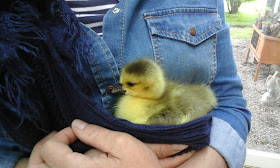Snares and fenn traps hanging on the side of our barn
Mike and I are doing a skills swap. Last year our neighbour Bill taught me a better way to catch moles, and I was able to clear our orchard of the little furry devils. I'm going to teach Mike the BMM (Bill Mole-catching Method) and he is teaching me to set fox snares. I've used cage traps but never snares to catch a fox.
I like the idea of snares since there's no poison involved, and non-target species that get snared can easily be let go. Especially badgers which, when caught in a snare, curl up and go to sleep until you wake them and cut them free (at which point a badger is wide awake and pissed off). Only non-locking snares are legal, so when an animal relaxes, the snare relaxes too. Animals too small (pheasants) or too big (deer) just knock the snare and it won't catch anything until it's re-set. In the UK, snares have to be checked every 24 hours
minimum.
Mike checks snares in the morning, Ian checks them in the evening. I accompany Mike to check his snare line so he can talk me through how and where to set snares. "Where" is usually obvious by looking at paths travelled under fences, where the ground is bare of weeds from use, or hairs are caught on barbed wire.
The snare has to blend in with its surroundings. New snares are shiny and have to be "weathered", which is why we leave ours hanging on the side of the barn (or treat them with baking soda if we need them right away). Animals distrust objects that stand out from their surroundings. Look closely at the photo below which shows a treated snare set in a run.
Gateways and tracks used by people and vehicles are regularly used by animals too. To set a snare on an open track or underneath a long gate requires patiently blocking off more and more of the gap with logs and rocks over a period of days. The fox gets used to seeing an obstruction and goes around. The obstruction, just logs and rocks to the fox, gets larger and longer and eventually guides the fox through the only remaining gap - and a snare.
On our last check together, we found a fox in one of the snares.
It was a dog fox, the second of a pair. Ian caught the vixen a few days earlier. I despatched the dog fox with a shotgun and set a new snare wire while Mike talked me through the process.
Mike tells me that fox skins used to be worth money and a gamekeeper was allowed to supplement his income by selling the fox skins. Now there is no commercial use for the animal but because of vulnerable farmed livestock like lambs and chickens, fox populations are still managed in the countryside. It's not my favourite job.
Many snares are set at the same time, along a length of fencing, as animals use lots of paths on their daily rounds. We check about 40 snares on our daily round. We can check rat/squirrel traps at the same time.
Rats and squirrels are trapped using fenn traps. These are what most people think of when imagining a trap: the animal steps on a plate and spring-loaded bars snap shut.
We use barrels with openings cut to allow squirrels inside, and bait the barrel with wheat. Two fenn traps nestle in the wheat on the bottom of the barrel. We can check our traps by unscrewing the lid from the barrel or, if one of the dogs is with me, she will circle the barrel and wag her tail which is a pretty good sign the trap is full.
There are many concerns over grey squirrels in the UK. Primarily grey squirrels are a non-native species, and they carry a squirrel pox that is killing native red squirrels where their territories overlap. (There are no red squirrels in our area, or we wouldn't be able to trap using the barrel method, as we couldn't guarantee not to catch red squirrels.)
Fenns can be used to catch rats too. The fenn sits inside a small tunnel, and two sticks are poked in the ground at the opening of the tunnel, in an "X" shape, to block curious pheasants wandering in
These traps are only for rats in the woods. Nearer to home, we shoot the ones we can see. There is a nest in the roots of a tree outside the back door. The rats make regular forays from their tree nest to the chicken feeder 25 feet away. The deal is when you're having your morning/evening cup of tea, you have to keep the .410 shotgun handy and the back door open. If a rat makes a run for it, shoot it. Mike has killed the most, I'm lagging way behind. My excuse is that I drink my tea in the car while running errands, not sat down by the back door.
We use a 4-wheel drive buggy to reach all the traps. And this is why.








